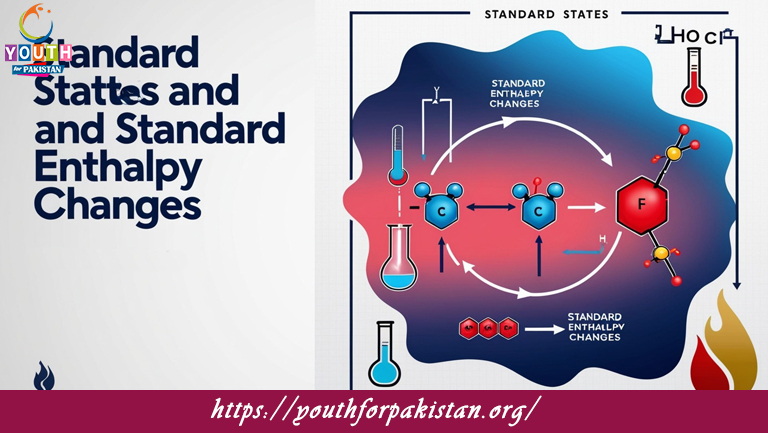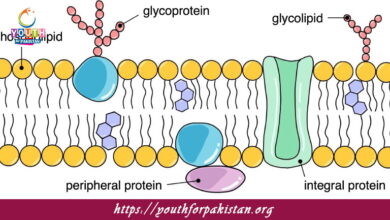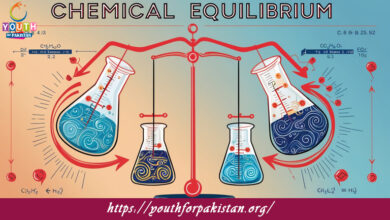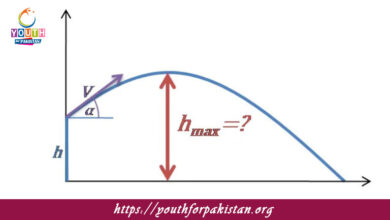Standard States And Standard Enthalpy Changes MDCAT MCQs

Welcome to the Standard States And Standard Enthalpy Changes MDCAT MCQs with Answers. In this post, we have shared Standard States And Standard Enthalpy Changes Multiple Choice Questions and Answers for PMC MDCAT 2024. Each question in MDCAT Chemistry offers a chance to enhance your knowledge regarding Standard States And Standard Enthalpy Changes MCQs in this MDCAT Online Test.
The standard state of a substance is defined as:
a) The state of the substance at room temperature
b) The state of the substance at its boiling point
c) The state of the substance at 1 atm pressure and 25°C
d) The state of the substance at its melting point
The standard enthalpy of formation (ΔHf°) refers to:
a) The heat change when one mole of a substance is formed from its elements in their standard states
b) The heat released during the combustion of one mole of a substance
c) The heat absorbed when a substance dissolves in water
d) The heat required to vaporize one mole of a substance
The standard enthalpy of combustion (ΔHc°) is:
a) The heat change when one mole of a substance is burned in oxygen
b) The heat change when one mole of a substance is formed from its elements
c) The heat change when a substance dissolves in water
d) The heat required to convert one mole of a liquid to a gas
The standard state of a gas is at:
a) 1 atm pressure
b) 2 atm pressure
c) 0.5 atm pressure
d) 1 bar pressure
The standard enthalpy change of formation for an element in its standard state is:
a) Zero
b) Positive
c) Negative
d) Variable
The enthalpy change when a substance is dissolved in water is called:
a) Enthalpy of solution
b) Enthalpy of formation
c) Enthalpy of combustion
d) Enthalpy of vaporization
The standard enthalpy change for the reaction of hydrogen and oxygen to form water is:
a) The enthalpy of formation of water
b) The enthalpy of combustion of hydrogen
c) The enthalpy of vaporization of water
d) The enthalpy of solution of hydrogen
The standard enthalpy change of reaction (ΔHr°) is measured under:
a) Standard temperature and pressure (STP)
b) Standard pressure only
c) Standard temperature only
d) Standard pressure and temperature
The standard state of a substance refers to:
a) The most stable form of the substance at 1 atm and 25°C
b) The form of the substance at its highest temperature
c) The form of the substance at its highest pressure
d) The form of the substance at its melting point
The standard enthalpy of vaporization is:
a) The heat required to convert one mole of a liquid into a gas
b) The heat released when one mole of a substance is burned
c) The heat change when one mole of a substance is dissolved
d) The heat change when one mole of a substance is formed from its elements
The standard enthalpy of formation for CO2 is:
a) The heat change when CO2 is formed from its elements
b) The heat change when CO2 is burned
c) The heat change when CO2 is dissolved in water
d) The heat required to convert CO2 to a gas
The enthalpy change for a reaction can be obtained from:
a) The standard enthalpies of formation of the reactants and products
b) The standard enthalpy of vaporization of the reactants
c) The standard enthalpy of combustion of the reactants
d) The temperature change during the reaction
The standard enthalpy of solution is:
a) The heat change when one mole of a substance dissolves in water
b) The heat change when one mole of a substance is formed from its elements
c) The heat change when one mole of a substance is burned
d) The heat change when a substance undergoes a phase change
For a reaction where ΔH°f = 0, the reaction is:
a) Formation of an element in its standard state
b) Formation of a compound from its elements
c) Combustion of a substance
d) Dissolution of a substance
The enthalpy change associated with converting one mole of a substance from a liquid to a gas is known as:
a) Enthalpy of vaporization
b) Enthalpy of fusion
c) Enthalpy of combustion
d) Enthalpy of formation
The standard enthalpy change for the combustion of methane is:
a) The heat released when methane burns in oxygen
b) The heat absorbed when methane is formed
c) The heat released when methane dissolves in water
d) The heat absorbed when methane vaporizes
The enthalpy change for a reaction is independent of:
a) The reaction path
b) The temperature
c) The pressure
d) The concentrations of reactants
The standard enthalpy change of reaction (ΔHr°) is determined:
a) At constant temperature and pressure
b) At constant volume and temperature
c) At constant concentration and temperature
d) At constant pressure and volume
The standard state of a liquid is at:
a) 1 atm pressure and its melting point
b) 1 atm pressure and its boiling point
c) 1 atm pressure and room temperature
d) 0.5 atm pressure and its freezing point
The heat absorbed or released during a chemical reaction is often reported in:
a) kJ/mol
b) J/g
c) kJ/g
d) J/mol
The standard enthalpy of formation for a compound is:
a) The heat change when the compound is formed from its elements
b) The heat change when the compound is burned
c) The heat change when the compound dissolves
d) The heat change when the compound undergoes a phase transition
The standard enthalpy of combustion is:
a) The heat released when one mole of a substance is burned completely in oxygen
b) The heat absorbed when one mole of a substance is formed from its elements
c) The heat released during the dissolution of one mole of a substance
d) The heat absorbed when one mole of a liquid is converted to a gas
The enthalpy change for a reaction is negative in a:
a) Exothermic reaction
b) Endothermic reaction
c) Isothermal reaction
d) Adiabatic reaction
The standard enthalpy of formation for CO2 can be calculated using:
a) The enthalpy of combustion of carbon and oxygen
b) The enthalpy of vaporization of CO2
c) The enthalpy of solution of CO2
d) The enthalpy of fusion of CO2
The standard enthalpy change of solution is measured when:
a) A substance dissolves in a solvent
b) A substance reacts with oxygen
c) A substance melts or boils
d) A substance forms from its elements
The enthalpy of reaction at constant pressure is equal to:
a) The change in enthalpy (ΔH)
b) The change in internal energy (ΔU)
c) The change in entropy (ΔS)
d) The change in free energy (ΔG)
The enthalpy change for a reaction can be determined using:
a) Hess’s Law
b) The law of mass action
c) Raoult’s Law
d) Le Chatelier’s Principle
The enthalpy of formation of a substance is defined at:
a) Standard conditions
b) Room temperature only
c) High pressure conditions
d) Any arbitrary temperature
The standard state of a solid is:
a) The most stable form at 1 atm and 25°C
b) The form at its melting point
c) The form at its boiling point
d) The form at its sublimation point
The enthalpy change when one mole of a substance is formed from its elements in their standard states is called:
a) Standard enthalpy of formation
b) Standard enthalpy of combustion
c) Enthalpy of vaporization
d) Enthalpy of fusion
The enthalpy of combustion of methane is:
a) The heat released when methane burns in excess oxygen
b) The heat absorbed when methane forms from carbon and hydrogen
c) The heat absorbed when methane dissolves in water
d) The heat released when methane vaporizes
The standard enthalpy of fusion is:
a) The heat required to convert one mole of a solid into a liquid at its melting point
b) The heat released when one mole of a substance burns in oxygen
c) The heat required to convert one mole of a liquid into a gas
d) The heat absorbed when one mole of a substance dissolves in water
The enthalpy of formation of an element in its standard state is:
a) Zero
b) Positive
c) Negative
d) The same as its enthalpy of combustion
The standard enthalpy change for a reaction can be calculated using:
a) The enthalpy changes of formation of reactants and products
b) The temperature change of the system
c) The pressure change of the system
d) The volume change of the system
The enthalpy change for the reaction of forming a gas from a liquid is called:
a) Enthalpy of vaporization
b) Enthalpy of fusion
c) Enthalpy of combustion
d) Enthalpy of formation
The standard enthalpy of combustion for a substance is typically:
a) Negative
b) Positive
c) Zero
d) Variable
The enthalpy change for the dissolution of a salt in water is:
a) Enthalpy of solution
b) Enthalpy of formation
c) Enthalpy of combustion
d) Enthalpy of vaporization
The standard enthalpy change of a reaction is the same whether:
a) The reaction occurs in one step or multiple steps
b) The reaction occurs at high pressure or low pressure
c) The reaction occurs at high temperature or low temperature
d) The reaction occurs in the presence or absence of a catalyst
The enthalpy change of reaction for a process occurring at constant pressure is equal to:
a) The heat absorbed or released
b) The work done by the system
c) The change in internal energy
d) The change in entropy
The enthalpy of fusion is defined as:
a) The heat required to convert one mole of a solid into a liquid
b) The heat released when one mole of a substance burns
c) The heat absorbed when one mole of a substance is vaporized
d) The heat absorbed when one mole of a substance dissolves in water
If you are interested to enhance your knowledge regarding Physics, Chemistry, Computer, and Biology please click on the link of each category, you will be redirected to dedicated website for each category.





